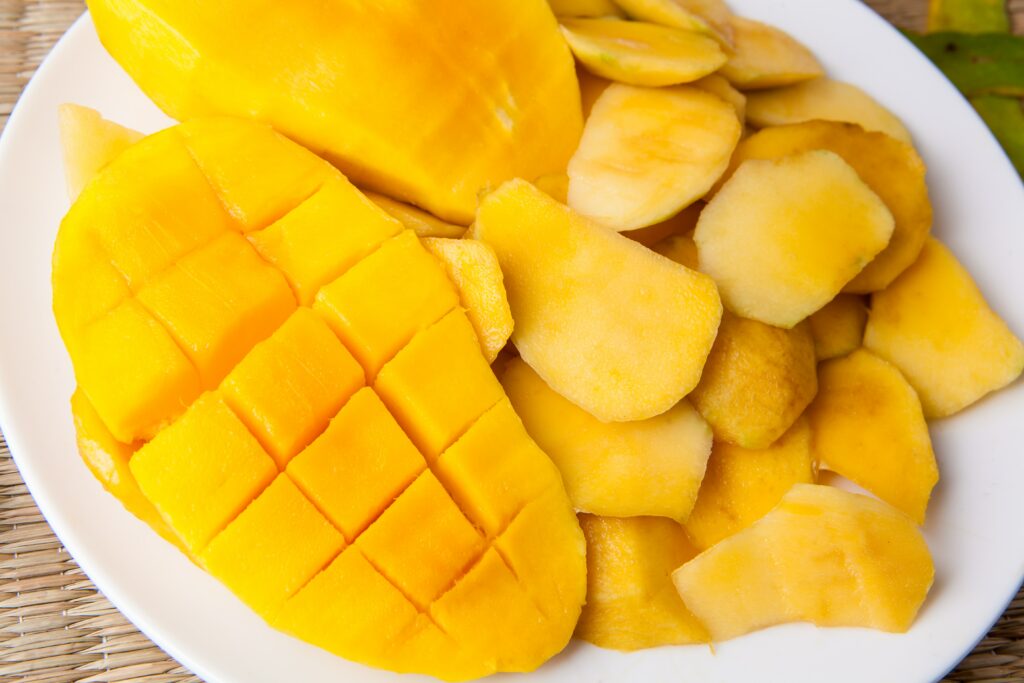Can Dogs Eat Mangos? Exploring the Benefits and Precautions
The short answer is yes. Mangos are a tropical fruit enjoyed by many humans for their sweet and juicy flavor. As a dog owner, you might wonder if mangos are safe and suitable for your furry companion. While dogs can eat mangos, there are important factors to consider before offering this fruit to your four-legged friend. In this article, we will explore the benefits of mangos for dogs, discuss safety precautions, and provide guidelines for serving mangos to your canine companion.

Benefits of Mangos for Dogs
Mangos offers several potential health benefits for dogs when given in moderation. They are a great source of vitamins and minerals, including vitamin C, vitamin A, and potassium. These nutrients contribute to a healthy immune system, improved vision, and proper muscle function in dogs. The natural fiber in mangos can also support healthy digestion and bowel movements.
Furthermore, mangos contain antioxidants, such as beta-carotene and quercetin, which can help reduce inflammation and oxidative stress in your dog’s body. These properties make mangos a potentially beneficial addition to your dog’s diet, promoting overall well-being and supporting their immune system.
Safety Precautions
While mangos can provide health benefits, it’s crucial to exercise caution and take necessary precautions when feeding them to your dog. Here are some important safety measures to keep in mind:
First, always remove the mango pit before offering it to your dog. Mango pits contain a small amount of cyanide, which can be toxic if ingested. Ensure that your dog cannot access the pit, as it presents a choking hazard and can cause intestinal blockages.
Second, introduce mangos to your dog gradually, especially if they haven’t had them before. Start with a small amount and monitor for any signs of allergic reactions, such as itching, swelling, or gastrointestinal issues. If any adverse reactions occur, discontinue feeding mangos and consult your veterinarian.
How to Prepare and Serve Mangos to Your Dog
To safely serve mangos to your dog, follow these preparation and serving guidelines:
Start by washing the mango thoroughly to remove any dirt or residue from the skin. Then, peel the mango, ensuring you remove all the skin as it can be tough and difficult for dogs to digest. Slice the mango flesh away from the pit and cut it into small, bite-sized pieces suitable for your dog’s size. This makes it easier for your dog to chew and swallow.
You can offer the mango pieces to your dog as a treat, either hand-feeding them or placing the slices in their food bowl. Alternatively, for a refreshing treat on a hot day, freeze the mango pieces and offer them to your dog as a frozen snack.
Monitoring Your Dog’s Response
As with any new food, it’s important to observe your dog’s response when introducing mangos. Monitor for any signs of digestive issues such as diarrhea or vomiting. If you notice any adverse reactions, discontinue feeding mangos to your dog.
Additionally, be aware that some dogs may have individual sensitivities or allergies to mangos. If you observe signs of an allergic reaction, such as itching, swelling, or difficulty breathing, stop feeding mangos and consult your veterinarian for further guidance.
Conclusion
In conclusion, dogs can eat mangos in moderation and enjoy potential health benefits from this tropical fruit. However, it’s crucial to remove the pit, introduce mangos gradually, and monitor your dog’s response for any adverse reactions. Always consult with your veterinarian before introducing new foods to your dog’s diet.
Ernest is pet owner, software developer and dad of 3